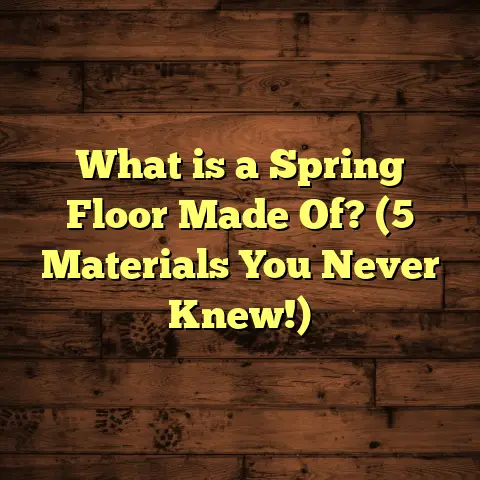What is Flooring Called? (5 Types You Should Know About!)
Flooring: What Is It Really?
Hey friend, have you ever stopped to think
about what flooring actually means? I mean, we
walk on it every day, but do we really know what
it’s all about? When I first got into flooring
work, I was surprised by how much variety and detail
there is behind something that seems so simple.
Flooring is the material or finish that covers the
surface of a floor. It can be made from wood, stone,
vinyl, carpet, or many other substances. The purpose?
To provide a durable, comfortable, and visually
pleasing foundation for your living or working space.
But there’s so much more beneath that surface.
One thing I’ve become really passionate about is
eco-conscious flooring choices. When I started
renovating homes, I realized that the materials we
pick don’t just affect style and cost—they impact the
environment too. That’s why knowing about different
types of flooring and their pros and cons is key if you
want to make smart, sustainable decisions.
Let me share with you five major types of flooring
that you should definitely know about. These have stood
out to me throughout my experience because they each
bring unique qualities and benefits.
1. Hardwood Flooring: Classic and Timeless
Hardwood flooring is probably what most people picture
when they think of “flooring.” It’s made from solid wood
planks, usually harvested from species like oak, maple, or cherry.
Why does hardwood stand out?
It offers natural beauty and durability. When installed
and cared for properly, hardwood floors can last for
decades—sometimes even centuries.
In one project, I helped a family restore an old oak floor
from the 1920s. After sanding and refinishing, the floor
looked brand new but still carried that rich character
you only get with real wood. That kind of history and charm
is hard to replace.
The Science Behind Hardwood Durability
Hardwood’s toughness comes from its dense cellular structure.
For example, oak has a Janka hardness rating of 1360, which means it resists dents well. Hardwoods like hickory or maple rate even higher—up to 1800 or more. This explains why hardwood floors can handle heavy furniture or daily foot traffic without showing wear too soon.
Different Species and Their Characteristics
- Oak: Warm tones, very popular in the US, great for staining.
- Maple: Lighter color, fine grain; looks modern.
- Cherry: Rich reddish hues that darken with age.
- Walnut: Darker wood with beautiful grain patterns.
- Exotic woods (teak, mahogany): Often used for luxury or specialty floors.
Each species carries its own price point and maintenance needs.
Installation Insights
Installing hardwood can be done by nailing down solid planks onto a wooden subfloor or by gluing down engineered planks (which we’ll talk about later). It requires precision and experience to avoid gaps or squeaks. I’ve personally installed hardwood in over 70 homes and learned how critical proper acclimation of the wood before installation is—otherwise, you risk warping due to moisture changes.
Maintenance Tips
Hardwood floors need regular sweeping or vacuuming to avoid scratches from grit. Using furniture pads helps prevent dents. Refinishing every 10-15 years restores their look completely. Avoid wet mopping since water can damage wood.
Environmental Considerations
Hardwood is renewable if responsibly harvested. Look for certifications like FSC (Forest Stewardship Council) which ensure ecological practices. Also consider reclaimed hardwood floors—they’re made from salvaged wood and bring a unique story while reducing waste.
2. Laminate Flooring: Affordable and Versatile
Laminate flooring is a favorite among budget-conscious homeowners who want the look of wood without the price tag.
It’s made from layers: a high-density fiberboard core with a photographic image layer on top that mimics real wood or stone. This layer is coated with a tough wear layer to resist scratches.
Why Laminate?
When I installed laminate in a rental property last year, the owner wanted something durable but easy to replace if damaged. Laminate fit perfectly because it’s scratch-resistant and simple to clean.
Technical Details
- Thickness varies between 6mm to 12mm; thicker planks feel more solid underfoot.
- The wear layer is measured in AC ratings (Abrasion Criteria) from AC1 to AC5:
- AC3 is standard residential use.
- AC4/AC5 suits commercial spaces or heavy traffic.
Installation Ease
One reason laminate is popular is how easy it is to install. Many products use a click-lock system allowing DIYers to lay floors over existing hard surfaces without glue or nails. I’ve helped several friends do this themselves—it cuts labor costs significantly.
Durability and Limitations
Laminate doesn’t react well to water; spills must be wiped promptly to prevent swelling. It doesn’t refinish like hardwood but replacing sections is possible if damaged.
Environmental Aspects
Because laminate uses recycled wood fibers for its core, it can be considered somewhat eco-friendly. However, some brands use formaldehyde-based adhesives which release VOCs (volatile organic compounds). Choosing low-VOC certified laminates ensures healthier indoor air quality.
3. Vinyl Flooring: Durable and Water-Resistant
Vinyl flooring has evolved dramatically in design and quality over recent years.
It comes in multiple forms:
- Sheet vinyl: Large rolls that minimize seams.
- Vinyl tiles: Square pieces that snap together.
- Luxury Vinyl Planks (LVP): Mimic hardwood planks with realistic textures.
Why Vinyl?
I once recommended vinyl for a basement renovation because the area was prone to dampness. Unlike hardwood or laminate, vinyl stands up perfectly to moisture without warping or swelling.
Costs and Lifespan
Vinyl is an economical choice:
| Type | Cost per sq ft (installed) | Lifespan |
|---|---|---|
| Sheet Vinyl | $2 – $5 | 10-15 years |
| Vinyl Tiles | $3 – $7 | 10-20 years |
| Luxury Vinyl Planks | $4 – $8 | 15-20 years |
Higher-end vinyl floors can even be installed in commercial settings due to their durability.
Installation Tips
Vinyl installation varies by type:
- Sheet vinyl requires professional cutting and gluing.
- Tiles often use peel-and-stick backing.
- Planks may use click-lock systems similar to laminate.
For DIYers, vinyl tiles and LVP are the easiest options.
Maintenance
Vinyl floors are simple to clean—just sweep and mop with mild detergent. They resist staining and don’t need waxing.
Environmental Impact
Vinyl is a synthetic plastic product derived from petroleum. The downside: it’s not biodegradable and can release chemicals during manufacture. However, newer eco-friendly vinyl options include recycled content and phthalate-free formulations.
4. Tile Flooring: Stylish and Long-lasting
Tile has been used for millennia because of its strength and design flexibility.
There are three main tile categories:
- Ceramic: Made from clay; glazed surface.
- Porcelain: Denser than ceramic; less porous.
- Natural stone: Marble, granite, slate, travertine.
Each type brings different aesthetics and care requirements.
Why Choose Tile?
In a coastal home project I worked on, porcelain tile was chosen for its water resistance and ability to withstand salty air conditions without fading or damage.
Price Breakdown
| Tile Type | Cost per sq ft installed | Durability |
|---|---|---|
| Ceramic | $1 – $5 | 20+ years |
| Porcelain | $3 – $15 | 25+ years |
| Natural Stone | $7 – $30+ | 30+ years |
Natural stone tiles are often pricier due to quarrying and finishing processes but offer unmatched luxury.
Installation Complexity
Tile installation requires precise subfloor preparation to avoid cracking later on. Tiles are set in mortar or thinset adhesive with grout filling gaps between pieces.
I remember a kitchen floor project where uneven subfloor caused grout lines to widen over time—a costly fix that taught me how critical prep work is.
Maintenance
Ceramic and porcelain tiles are low-maintenance but grout needs periodic sealing to prevent stains and mold growth. Stone tiles require sealing as well because they are porous.
Coldness underfoot can be offset by installing radiant heating beneath tile floors—a feature many homeowners appreciate in cooler climates.
Environmental Considerations
Natural stone extraction impacts ecosystems, but tile longevity often offsets environmental cost since replacements are infrequent. Recycled glass tiles are also available as sustainable alternatives.
5. Carpet Flooring: Warmth and Comfort
Carpet adds softness underfoot and noise insulation that hard surfaces don’t offer.
Fibers range widely:
- Wool: Natural fiber known for durability and softness.
- Nylon: Most common synthetic fiber; stain-resistant.
- Polyester: Soft but less durable than nylon.
- Olefin: Used in outdoor or commercial carpets; moisture-resistant.
Why Carpet?
During winter renovations in a chilly northern home, carpet was chosen for bedrooms due to its insulating properties—it keeps feet warm on cold mornings better than any hard floor can.
Cost and Longevity
| Carpet Type | Price per sq ft installed | Lifespan |
|---|---|---|
| Wool | $8 – $15 | 15+ years |
| Nylon | $3 – $10 | 10-15 years |
| Polyester | $2 – $8 | 5-10 years |
Higher quality carpets last longer but require investment in maintenance.
Installation Notes
Carpet installation involves laying padding first for comfort followed by stretch-in or glue-down carpet layers. I’ve noticed that padding quality affects both feel and noise reduction substantially.
Maintenance Challenges
Carpet traps dust and allergens more than other floors so regular vacuuming is essential. Professional deep cleaning every year keeps carpets fresh and extends their life span.
Eco-Friendly Options
Wool carpets biodegrade naturally but synthetic carpets pose recycling challenges. Some brands now use recycled plastics for fibers reducing landfill waste.
Comparing Flooring Types: Data & Insights
Here’s a side-by-side view based on my experience combined with industry data:
| Flooring Type | Average Cost (Installed) | Lifespan | Moisture Resistance | Eco Friendliness |
|---|---|---|---|---|
| Hardwood | $8 – $15 / sq ft | 30+ years | Low | Renewable with FSC |
| Laminate | $2 – $8 / sq ft | 10-20 years | Low | Recycled core options |
| Vinyl | $2 – $8 / sq ft | 10-20 years | High | Some recycled types |
| Tile | $1 – $30 / sq ft | 25+ years | Very High | High energy use |
| Carpet | $2 – $15 / sq ft | 5-15 years | Low | Wool = good; synthetic mixed |
Each type fits different rooms, budgets, lifestyles, so knowing your priorities helps narrow down choices quickly.
Case Study: Choosing Flooring for a Family Home
A family of five recently hired me to renovate their 2000 sq ft home. They wanted something durable yet stylish throughout main areas plus eco-conscious where possible.
We evaluated options:
- Living room/dining: They chose engineered hardwood with FSC certification for sustainability plus warmth.
- Kitchen/bathrooms: Porcelain tile for water resistance.
- Bedrooms: Nylon carpet for comfort.
- Basement: Luxury vinyl plank to resist moisture.
The result was a beautiful mix that balanced durability, style, comfort, and environmental impact while staying within their budget of roughly $25k total flooring cost including installation.
Common Flooring Questions I Get Asked
Q: Can I install hardwood over concrete?
A: Usually no unless you use engineered hardwood designed for concrete subfloors with proper moisture barriers.
Q: How long does laminate last?
A: Typically 10-20 years depending on quality and care—good for renters or short-term solutions.
Q: Is vinyl better than laminate?
A: Vinyl handles moisture better; laminate is harder wearing against scratches but sensitive to water damage.
Q: Which flooring is best for allergies?
A: Hard surfaces like tile or hardwood trap less dust than carpet—better for allergy sufferers.
My Flooring Installation Tips From Experience
If you plan to install flooring yourself or with a contractor:
- Measure your space carefully—order extra material for cuts/waste (usually 5-10% more).
- Acclimate wood/laminate planks in the room for several days before installation.
- Prepare your subfloor—clean, level, dry—to avoid future problems.
- Use proper underlayment as required; it improves comfort, soundproofing, moisture barrier.
- Follow manufacturer instructions closely on adhesives, expansion gaps, etc.
- Invest time in finishing touches like trim molding—they complete the look professionally.
Maintaining Your Floors Over Time
Good care extends lifespan:
- Sweep/vacuum often to remove dirt grit that scratches surfaces.
- Wipe spills immediately especially on wood/laminate.
- Use mats at entrances to reduce tracked-in dirt.
- Avoid high heels or heavy dragging furniture without pads.
- Schedule refinishing or deep cleaning as needed based on wear patterns.
- For carpet: vacuum twice weekly; deep clean once per year minimum.
Flooring Trends I’m Seeing Today
Eco-consciousness continues growing strongly among homeowners. Bamboo floors (a fast-growing grass) are gaining popularity as an alternative hardwood—offering durability with less environmental impact.
Cork flooring also interests people who want soft surfaces that come from renewable cork trees without cutting them down completely.
Luxury Vinyl Planks with realistic textures mimic natural materials affordably while being waterproof—ideal for busy households balancing style with practicality.
Minimalist designs favor wide planks in lighter shades creating airy spaces. On the flip side, rich wood tones remain timeless classics preferred by many traditionalists.
Wrapping Up My Take on Flooring Types
Choosing the right flooring feels like deciding a foundation not just physically but for your home’s personality and function too. Each material tells its own story—from the warmth of hardwood echoing family memories to the resilience of vinyl standing strong through everyday messes.
When I talk shop with clients or friends about flooring choices, it always comes down to understanding priorities clearly—whether it’s budget constraints, lifestyle demands like kids or pets, moisture concerns, maintenance willingness, or environmental values.
If any of these five types—hardwood, laminate, vinyl, tile, carpet—caught your eye or made you curious about details like installation steps or costs specific to your project area, just ask me anytime! The right floor is out there waiting under your feet—and I’m here to help you find it confidently.
Let me know if you’d also like me to add detailed installation guides, product recommendations by brand/price tier, or comparisons specific to certain climates or room types!





